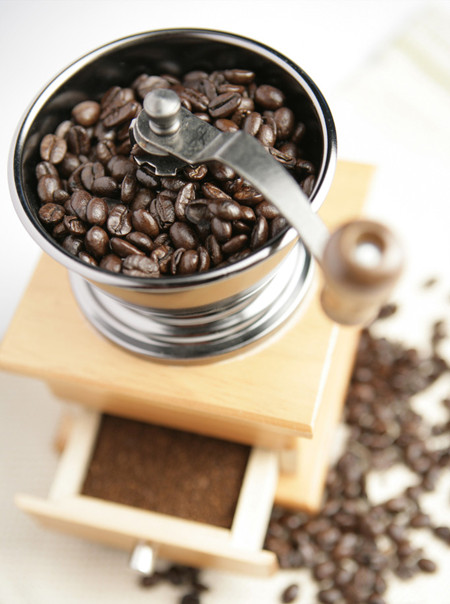Oiled coffee beans and freshness
Have you ever seen coffee beans that look oily? Why do some coffee beans have an oily surface, while others are "dry and comfortable" without oil? What is the relationship between coffee beans and freshness? Should we buy coffee beans that look "oily" or "not oily"?

Coffee oil is not oil.
These "oils" evenly distributed on the surface of coffee beans are not actually "oils", but water-soluble organic substances that look like oils. Coffee oil itself contains many coffee aroma components that dissolve in water, so the surface of your brewed coffee does not float a layer of greasy grease.
There are two reasons for "oil beans"
a) stale light baked beans
Light baked beans, which are light brown in appearance, dry in appearance and do not produce oil after baking. About five days after roasting (it may be shortened to one or two days in high summer), the phenomenon of "spotty oil" begins to appear (the appearance of spotty oil droplets on one side of the coffee beans). Please note that a little "spotty oil" does not mean that the coffee beans are not fresh, but sometimes the flavor of the light roast coffee beans is at its peak. Continue to put it down, after more than two weeks, the surface of the light baked beans gradually appears a layer of uniform, thin and bright oil, smell not sweet, but with the smell of oil consumption, at this time, the flavor of "light baked beans" has declined, should avoid buying.
b) Fresh deep-baked beans
Dark baked beans, which are dark brown in appearance, appear slightly oily after baking, and a large amount of oil begins to appear on the surface from the first day to the second day after baking. Deep baked beans with shiny appearance do not mean that they are not fresh. On the contrary, deep baked beans will gradually dry out after three weeks, and finally become dry and stale beans. Therefore, if you see coffee beans that are dry and not oily, but appear dark brown in appearance, please pay special attention to whether they are marked with roasting date.
How to judge the freshness of coffee beans.
Even if it is already stale, the appearance of "light baked beans" will gradually dry after a long time (such as three months), and finally return to a dry and oily appearance. It can be seen that whether the appearance of oil is only a reference to judge the freshness of coffee beans, not absolute.
How should we judge the freshness of coffee beans?
First of all, please purchase from a professional coffee roaster who clearly labels the date of the product, has a brand reputation, and emphasizes fresh roasting.
In addition, good coffee bags usually have a "one-way vent valve"(a button-like hole in the top of the coffee bag) design that allows the coffee beans to vent naturally occurring carbon dioxide. The one-way exhaust valve at the nose, gently squeeze the coffee bean bag, smell the squeezed gas taste, if it is a charming aroma of coffee, freshness is not a problem, on the contrary, if it smells not strong enough, or even with the smell of smelly oil, it means that this packet of coffee has long deteriorated and should be avoided.
- Conclusion-
"Freshly baked light-baked beans should be dry and oil-free on the surface, and fresh-baked deep-baked beans should be oily on the surface" is a correct concept that we should understand. When buying coffee beans, the appearance of oil, no oil is a reference index to judge freshness, but not absolute. The best policy is to select reputable businesses and open your eyes to buy.
Important Notice :
前街咖啡 FrontStreet Coffee has moved to new addredd:
FrontStreet Coffee Address: 315,Donghua East Road,GuangZhou
Tel:020 38364473
- Prev

Honey treatment of Coffee Bean
When it comes to the new stars in the production process of boutique coffee, we have to mention "honey treatment". At the WSC competition, known as the Coffee World Cup, the Angel Coffee Manor built by Taiwan in Central America and Nicaragua won the runner-up in 2010 with "Honey treated beans", becoming the pride of the Chinese coffee industry.
- Next

Talk about the blending of coffee beans.
Although some fixed varieties of coffee can be drunk directly as individual coffee, some coffees have more or less defects in flavor. For example, there is no special flavor, lack of depth, not strong enough, or a certain taste is too strong. In order to make up for these deficiencies, it is necessary to combine several kinds of coffee beans with different characteristics to create a harmonious and deep flavor.
Related
- Guji coffee producing area of Guji, Ethiopia: Humbela, Shakiso, Wulaga
- What is the most expensive variety of Qiloso in BOP multi-variety group?
- How to store the coffee beans bought home?
- Why are Yemeni coffee beans so rare now?
- Ethiopian Sidamo all Red Fruit Sun Sun Santa Vini Coffee beans
- SOE is mostly sour? What does it mean? Is it a single bean? what's the difference between it and Italian blending?
- Is Italian coffee beans suitable for making hand-brewed coffee?
- How to choose coffee beans when making cold coffee? What kind of coffee beans are suitable for making cold coffee?
- Just entered the pit to make coffee, what kind of coffee beans should be chosen?
- Can only Japan buy real Blue Mountain Coffee? What are authentic Jamaican Blue Mountain coffee beans?

